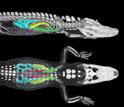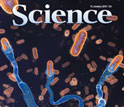News Release 10-007
Gators Breathe Like Birds
Did dinosaurs' ancestors inhale their way to dominance?

Results of a new study show that air moves in one direction once it enters an alligator's lungs.
January 14, 2010
This material is available primarily for archival purposes. Telephone numbers or other contact information may be out of date; please see current contact information at media contacts.
Scientists have discovered that air flows in one direction as it loops through the lungs of alligators, just as it does in birds.
The results, published in this week's issue of the journal Science, suggest that this breathing method may have helped dinosaurs' ancestors dominate Earth after the planet's worst mass extinction 251 million years ago.
Before and until about 20 million years after the extinction--called "the Great Dying" or the Permian-Triassic extinction--mammal-like reptiles known as synapsids were the largest land animals on Earth.
The extinction killed 70 percent of land life and 96 percent of sea life. As the planet recovered during the next 20 million years, archosaurs (Greek for "ruling lizards") became Earth's dominant land animals.
They evolved into two major branches on the tree of life: crocodilians, or ancestors of crocodiles and alligators, and a branch that produced flying pterosaurs, dinosaurs and eventually birds, which technically are archosaurs.
By demonstrating one-way or "unidirectional" airflow within the lungs of alligators, results of the new study suggest that such a breathing pattern likely evolved before 246 million years ago, when crocodilians split from the branch of the archosaur family tree that led to pterosaurs, dinosaurs and birds.
That, in turn, indicates that one-way airflow evolved in archosaurs earlier than once thought, says Mary Chamberlin of the National Science Foundation (NSF)'s Division of Integrative Organismal Systems, which funded the research.
It may explain why those animals came to dominance in the Early Triassic Period, after the extinction and when the recovering ecosystem was warm and dry. Oxygen levels then were perhaps as low as 12 percent compared with 21 percent today.
"The real importance of this air-flow discovery in gators is it may explain the turnover in fauna between the Permian and the Triassic, with the synapsids losing their dominance and being supplanted by archosaurs," says C.G. Farmer, the paper's principal author and a biologist at the University of Utah. "That's the major reason this is important scientifically."
Even with much less oxygen in the atmosphere, "many archosaurs, such as pterosaurs, apparently were capable of sustaining vigorous exercise," Farmer adds. "Lung design may have played a key role in this capacity because the lung is the first step in the cascade of oxygen from the atmosphere to the animal's tissues, where it is used to burn fuel for energy."
Farmer emphasized that the discovery does not explain why dinosaurs, which first arose roughly 230 million years ago, eventually outcompeted other archosaurs.
Farmer conducted the study with Kent Sanders, a radiologist at the University of Utah School of Medicine. They performed CT scans of a 4-foot-long, 24-pound alligator.
The synapsids--which technically include modern mammals--occupied ecological niches for large animals before the Permian-Triassic extinction.
"Some reached bear size," says Farmer. Some were meat-eaters, others ate plants. They were four-footed and had features suggesting they were endurance runners. Their limbs were directly under their body instead of sprawling outward like a lizard's legs. There is evidence they cared for their young.
The cause of the mass extinction 251 million years ago is unknown; theories include massive volcanism, an asteroid hitting Earth, and upwelling of methane gas that had been frozen in seafloor ice.
"A few of the synapsids survived the mass extinction to re-establish their dominance in the early Triassic, and the lineage eventually gave rise to mammals in the Late Triassic," says Farmer. "However, the recovery of life in the aftermath of the extinction involved a gradual turnover of the dominant terrestrial vertebrate lineage, with the archosaurs supplanting the synapsids by the Late Triassic."
From then until the dinosaurs died out 65 million years ago, any land animal longer than about three feet was an archosaur, says Farmer, while mammal-like synapsid survivors "were teeny little things hiding in cracks. It was not until the die-off of the large dinosaurs 65 million years ago that mammals made a comeback and started occupying body sizes larger than an opossum."
No one knows much about the archosaur that was the common ancestor of crocodilians and of pterosaurs, dinosaurs and birds, Farmer says.
It probably was "a small, relatively agile, insect-eating animal," Farmer says. "Illustrations of early archosaurs look like large lizards. Our data provide evidence that unidirectional flow of air in the lungs predates the origin of pterosaurs, dinosaurs and birds, and evolved in the common ancestor of the crocodilian and bird and pterosaur and dinosaur lineages."
In the lungs of humans and other mammals, airflow is like the tides. When we inhale, the air moves through numerous tiers of progressively smaller, branching airways, or bronchi, until dead-ending in the smallest chambers, cul-de-sacs named alveoli, where oxygen enters the blood and carbon dioxide moves from the blood into the lungs.
It long has been known that airflow in birds is unidirectional, and some scientists suggest it also was that way in dinosaurs.
In modern birds, the lungs' gas exchange units are not alveoli, but tubes known as "parabronchi," through which air flows in one direction before exiting the lung. Farmer says this lung design helps birds fly at altitudes that would "render mammals comatose."
Some researchers have argued that unidirectional airflow evolved after crocodilians split from the archosaur family tree, arising among pterosaurs and theropod dinosaurs, the primarily meat-eating group that included Tyrannosaurus rex. Others have argued it arose only among coelurosaurs, a group of dinosaurs that also includes T. rex and feathered dinosaurs.
Unidirectional air flow in birds long has been attributed to air sacs in the lungs. But Farmer disagrees, since gators don't have air sacs, and says it's due to aerodynamic "valves" within the lungs.
She believes air sacs help birds redistribute weight to control their pitch and roll during flight. Farmer says many scientists simply assume air sacs are needed for unidirectional airflow.
-NSF-
-
CT images show side and top views of a 24-pound American alligator, with 3-D views of lungs.
Credit and Larger Version -
The researchers' finding appear in the January 15, 2010, issue of the journal Science.
Credit and Larger Version
Media Contacts
Cheryl Dybas, NSF, (703) 292-7734, email: cdybas@nsf.gov
Lee Siegel, University of Utah, (801) 581-8993, email: leesiegel@ucomm.utah.edu
The U.S. National Science Foundation propels the nation forward by advancing fundamental research in all fields of science and engineering. NSF supports research and people by providing facilities, instruments and funding to support their ingenuity and sustain the U.S. as a global leader in research and innovation. With a fiscal year 2023 budget of $9.5 billion, NSF funds reach all 50 states through grants to nearly 2,000 colleges, universities and institutions. Each year, NSF receives more than 40,000 competitive proposals and makes about 11,000 new awards. Those awards include support for cooperative research with industry, Arctic and Antarctic research and operations, and U.S. participation in international scientific efforts.
Connect with us online
NSF website: nsf.gov
NSF News: nsf.gov/news
For News Media: nsf.gov/news/newsroom
Statistics: nsf.gov/statistics/
Awards database: nsf.gov/awardsearch/
Follow us on social
Twitter: twitter.com/NSF
Facebook: facebook.com/US.NSF
Instagram: instagram.com/nsfgov




